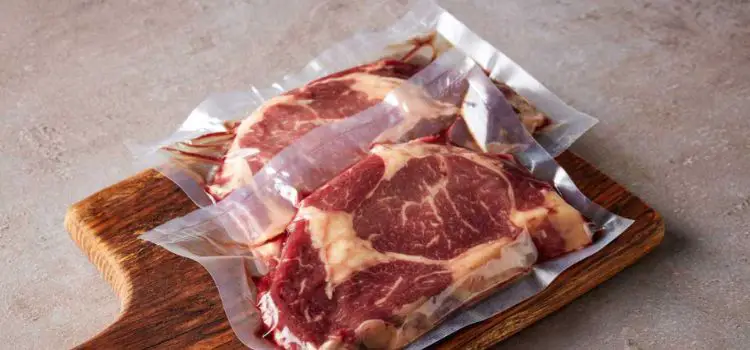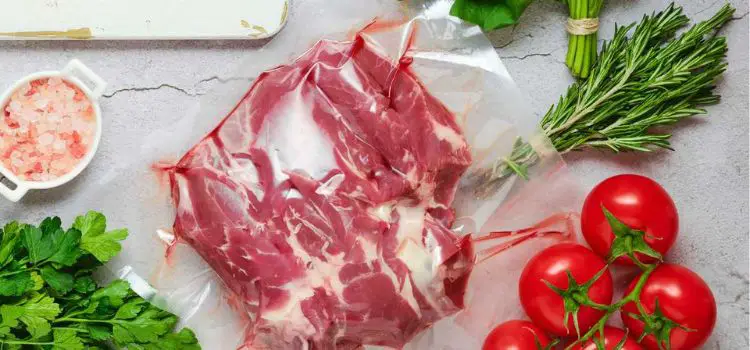As an Amazon Associate, I earn from qualifying purchases

The sous vide cooking method has become a culinary sensation, renowned for its ability to deliver precisely cooked, restaurant-quality meals right at home. Sous vide, which means “under vacuum” in French, involves cooking food sealed in a bag, submerged in a water bath at a consistent, controlled temperature. This technique ensures even cooking and preserves the natural flavors and juices of the food.
Vacuum packing, where air is removed from the packaging, plays a crucial role in the sous vide process, as it enhances the cooking experience by preventing oxidation and bacterial growth. The question arises—can you sous vide vacuum packed meat? The short answer is yes, and this approach offers a multitude of benefits, making your culinary adventures both convenient and rewarding.
Benefits of Using Vacuum-Packed Meat for Sous Vide
1. Retains Flavor and Moisture:
Vacuum-packed meat excels in preserving its natural flavors and moisture. By sealing in the juices, it prevents evaporation during cooking, resulting in an incredibly tender and flavorful dish. The meat cooks in its own juices, enhancing the overall taste.
2. Infuses Marinades and Seasonings:
The vacuum-sealing process allows marinades and seasonings to penetrate deeply into the meat. This results in a more intense flavor profile, making each bite even more delicious.
3. Convenience and Time-Saving:
Using pre-packaged vacuum-packed meats cuts down on preparation time. You can focus on other aspects of your meal, as the meat is ready to go. Simply place it in the water bath without the need for additional prep steps.
4. Enhanced Food Safety:
Vacuum-packed meat improves food safety by minimizing exposure to air and contaminants. This packaging helps extend the shelf life of the meat and reduces the risk of bacterial growth, especially when paired with the precise temperature control of sous vide cooking.
Tips for Ensuring Proper Cooking

To ensure the best results when sous vide cooking vacuum-packed meat, it is essential to check the integrity of the vacuum seal before starting. A compromised seal can introduce air pockets, which may cause uneven cooking or bacterial growth. Ensure that the package is tightly sealed with no leaks or air bubbles.
Sous vide cooking is all about precision, so adhering to proper temperature and timing guidelines is crucial. Different cuts and types of meat require specific temperatures to achieve the desired level of doneness. For instance, a steak might be cooked at 130°F for medium-rare, while a pork chop could be cooked at 140°F. It’s also important to adjust cooking times based on the thickness of the meat. Thicker cuts require longer cooking times to ensure the heat penetrates to the center.
Potential Challenges and Solutions
- Air Pockets in Vacuum-Sealed Bags: One common issue in sous vide cooking is air pockets within the vacuum-sealed bag, which can result in uneven cooking. To prevent this, ensure that seals are tight and consider investing in a heavier-duty vacuum sealer if you frequently encounter leaks.
- Keeping the Bag Submerged: It’s crucial for the bag to remain fully submerged during cooking. Air bubbles or buoyant materials can cause it to float, leading to inconsistent results. You can use weights or clips to keep the bag submerged in the water throughout the cooking process.
- Choosing Vacuum-Sealing Equipment: When selecting vacuum-sealing equipment, think about how often you plan to use it and the types of foods you’ll be sealing. For those who cook sous vide regularly, investing in a high-quality vacuum sealer can significantly enhance the reliability of your seals and improve the overall cooking experience.
Conclusion
Sous vide cooking with vacuum-packed meat offers countless benefits, from enhanced flavor and moisture retention to improved food safety and convenience. By following proper techniques and addressing potential challenges, you can effortlessly create exquisite dishes that impress every time. The simplicity and precision of sous vide, combined with the advantages of vacuum sealing, make it an ideal cooking method for both novice and experienced cooks alike.
As you explore the world of sous vide, experiment with different meats and recipes to discover new flavors and textures. For those eager to delve deeper, a wealth of resources is available to help you master sous vide techniques and elevate your culinary skills to the next level. Embrace the journey and enjoy the delectable results.
FAQ
Can you sous vide in vacuum sealed bags?
Yes, you can sous vide in vacuum sealed bags. This method is optimal for maintaining flavor and moisture during cooking. Ensure the bag has no air leaks and is properly sealed to prevent water intrusion, which can affect the cooking process and food safety.
Can you sous vide meat in a package?
Sous vide can be done with meat in a package if the packaging is heat-resistant and watertight. Ensure the packaging is free of BPA and can withstand sous vide temperatures. This method is convenient and can enhance flavor and tenderness while minimizing preparation time.
Will meat spoil if vacuum sealed?
While vacuum sealing significantly prolongs the freshness of meat by removing air and reducing oxidation, it does not prevent spoilage indefinitely. Meat must still be stored at appropriate temperatures in the refrigerator or freezer, and used within recommended timeframes to ensure safety and quality.
As an Amazon Associate, I earn from qualifying purchases